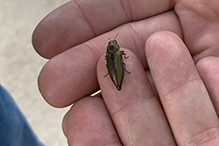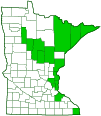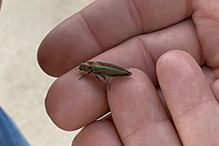striated jewel beetle
(Buprestis striata)
Conservation • Description • Habitat • Ecology • Distribution • Taxonomy
|
|
||||||||||||||
Description |
Striated jewel beetle is a medium-sized to large metallic wood-boring beetle. It occurs in the United States from Maine to Maryland, west through the Great Lakes states to Minnesota, and south along the Appalachian Mountain states to Georgia, and in Florida. It also occurs in southern Canada from Nova Scotia to Ontario. Adults and larvae are associated only with coniferous trees, mostly with pine, but also with hemlock and spruce. Adults are active in spring and early summer, when they can be seen on needles. They overwinter under the bark. The larvae are found in decaying stumps and logs, especially of trees in their second year of death. They are sometimes also found in living wood, where they create mines in the sapwood. If the mines encircle the trunk, the flow of sap stops and the tree dies. Adults are ½″ to ¾″ (13.0 to 20.0 mm) in length. The body is rigid, oblong, and broadly flattened. The overall color ranges from entirely dull coppery brown with coppery reflections, to coppery brown with some brilliant green or blue, to mostly brilliant green or blue with coppery brown at the margins. The male is narrower than the female. The head is slightly tucked under the broader first segment of the thorax (prothorax). The antennae have 11 segments. The fourth through eleventh segments are distinctly saw-toothed (serrate). The eyes are widely separated. The mouthparts are directed downwards. The plate on the upper side of the prothorax (pronotum) has a shallow depression in the middle from the rear almost to the front margin. The sides are almost parallel. The surface is coarsely pitted (punctate), but there are sometimes smooth areas on each side of the middle. It is mostly covered with long pale hairs, though these are often worn off in the middle. The plate between the wing bases (scutellum) is round and small but visible. The wing covers (elytra) are a little wider at the base than the pronotum. They are almost parallel at the base, widest just beyond the middle, and strongly narrowed to the tip. The tips are cut off (truncate). Each elytron has four shallowly raised, longitudinal ribs extending from the base to the tip, and an additional short rib at the side of the scutellum. The area between the ribs is flat and densely punctate. The species epithet striata translates to “striped”, but in entomology it means “grooved”. In this case, it is a misnomer. The elytra are ridged (costate), not grooved (striate). On the front legs, the fourth segment (tibia) does not have notches, a spine, or a tooth at the tip. The last part of each leg (tarsus), corresponding to the foot, has 5 segments. There is a pair of claws at the tip of each tarsus. The claws are equal in size, and they are simple, not split or toothed. |
Size |
Total length: ½″ to ¾″ (13.0 to 20.0 mm) |
Similar Species |
Habitat |
Decaying stumps and logs of pine, spruce, and hemlock |
Ecology |
Season |
Spring and early summer |
Behavior |
|
Life Cycle |
Adults overwinter under the bark. |
Larva Food |
|
Adult Food |
|
Distribution |
||
|
Sources |
|
| 6/1/2024 | ||
Occurrence |
||
Frequently encountered |
||
Taxonomy |
|
Order |
Coleoptera (Beetles) |
Suborder |
Polyphaga (Water, Rove, Scarab, Long-horned, Leaf, and Snout Beetles) |
Infraorder |
Elateriformia |
Superfamily |
Buprestoidea |
Family |
Buprestidae (jewel beetles) |
Subfamily |
Buprestinae |
Tribe |
Buprestini |
Genus |
Buprestis |
Subgenus |
Cypriacis |
Subordinate Taxa |
|
|
|
Synonyms |
|
Buprestis bruchi Buprestis canadensis Buprestis impedita Buprestis obscura |
|
Common Names |
|
striated jewel beetle |
|
Glossary
Elytra
The hardened or leathery forewings of beetles used to protect the fragile hindwings, which are used for flying. Singular: elytron.
Pronotum
The exoskeletal plate on the upper side of the first segment of the thorax of an insect.
Prothorax
The first (forward) segment of the thorax on an insect, bearing the first pair of legs but not wings.
Punctate
Dotted with pits (punctures), translucent sunken glands, or colored spots of pigment.
Scutellum
The exoskeletal plate covering the rearward (posterior) part of the middle segment of the thorax in some insects. In Coleoptera, Hemiptera, and Homoptera, the dorsal, often triangular plate behind the pronotum and between the bases of the front wings. In Diptera, the exoskeletal plate between the abdomen and the thorax.
Tarsus
On insects, the last two to five subdivisions of the leg, attached to the tibia; the foot. On spiders, the last segment of the leg. Plural: tarsi.
Tibia
The fourth segment of an insect leg, after the femur and before the tarsus (foot). The fifth segment of a spider leg or palp. Plural: tibiae.
Visitor Photos |
||
Share your photo of this insect. |
||
This button not working for you? |
||
Greg Watson |
||
 |
||
MinnesotaSeasons.com Photos |
||
|
||
|
||

Slideshows |
|

Visitor Videos |
||
Share your video of this insect. |
||
This button not working for you? |
||
|
Other Videos |
||
|

Created: 6/1/2024 Last Updated: © MinnesotaSeasons.com. All rights reserved. |



